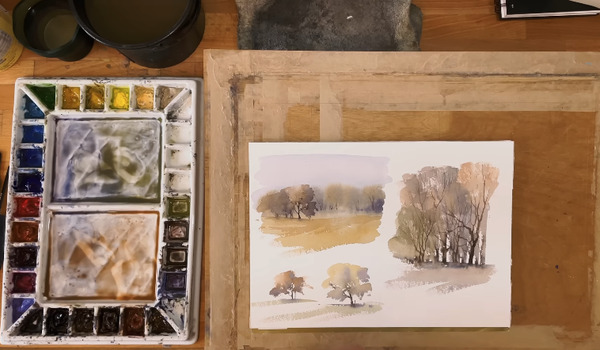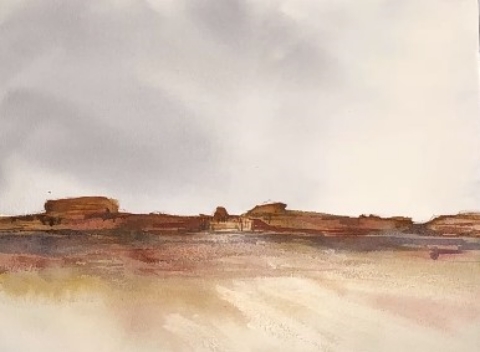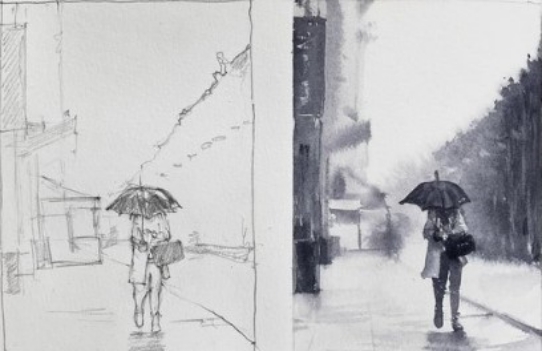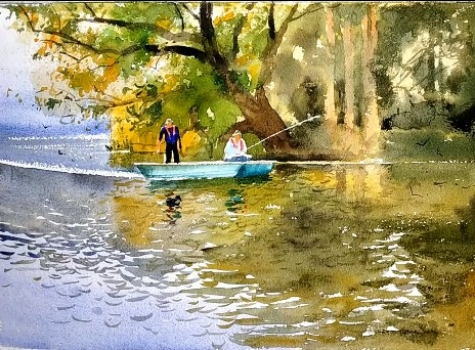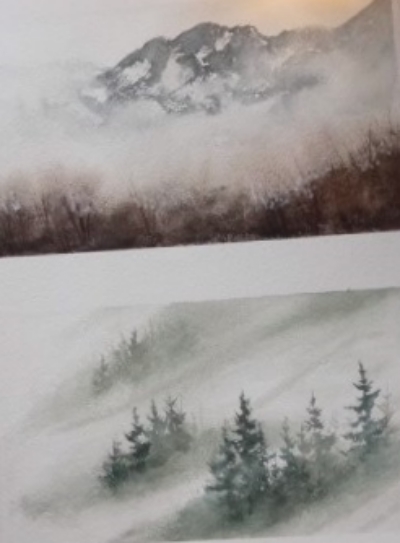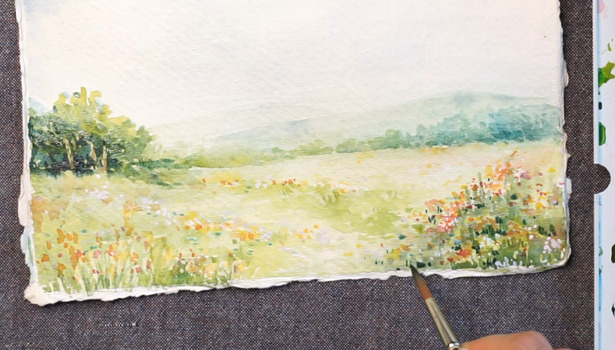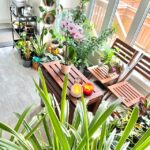This post may contain affiliate links. Please see our full Disclosure Policy for details.
Learn landscape watercolor painting with ideas and easy tutorials with steps and tips for beginners that with daily practice will benefit you.
From colorful sunsets to abstract mountains, the possibilities are as vast as the natural world itself. In this guide, we’ll explore a range of inspiring ideas tailored specifically for beginners, offering techniques and instructions to help you capture the beauty of landscapes with watercolors.
You will also like: Watercolor flower painting ideas

Watercolor Landscape Painting for Beginners
For beginners in watercolor landscape painting, here are some engaging ideas to explore
1) Mountain Landscape by My Art Aspirations.
2) Sky Landscape by Crafted By Robert.
3) Abstract Watercolor Landscape Painting by Watercolor affair.
4) Minimalist Nature Landscape Watercolor Painting by Art Studio Life.
5) Minimalist Landscape Step-by-Step Painting by East Peasy Art.
6) Rocky Beach shows how to paint rocks using a simple credit card for texture with a thin wash and adding thick pigment by Cheryl Bruce.
Best Watercolor Landscape Painting
7) Easy Loose Ink and Waterfall Sketching Basic Landscape by Jillee Art.
8) Japanese and Chinese Landscape by Traditional Chinese Paintings.
9) House Landscape Watercolor Painting by PS Art Gallery.
10) Watercolor Starry Night by Let’s Make Art.
11) Loose Watercolor Landscape Painting by Anastasia Mily.
12) Monochromatic Landscape uses just one color, making it easier to focus on learning how to control water and paint to create light and dark areas by Artbyro.
13) Atmospheric Landscape that requires no drawing skills, as this tutorial guides you through painting a dreamy scene with atmospheric clouds, shimmering reflections, and a serene white sail by Karen Rice Art.
14) Painting trees in watercolors by Oliver Pyle.
15) Wheat Field Landscape by Art Painting Workshop.
16) Christmas Barn with a background of soft blues and greens, setting the stage for a snowy landscape. Add a cozy house and pine trees, creating depth and interest by Julia Lis Art.
17) Ocean Wave with blues and turquoise, adding splashes of white for the wave’s foam by Ellen Crimi-Trent.
18) Saguaro Cactus Desert Landscape by Hugderr.
19) Fishing Boat Landscape with a detailed sketch and progressing through watercolor techniques by de Winton Paper Co.
20) Light House by Anastasia Mily.
Colorful Watercolor Landscape Paintings
21) Cottage with Garden by Paul Clark.
22) Tree Landscape watercolor step-by-step painting of an Autumn lake scenery for beginners by Ahmad Art.
23) Fall Landscape tutorial with wet-on-wet technique by de Winton Paper Co.
24) Hot Air Balloons by Art of John Magne Lisondra.
25) How to paint light in watercolors by Mathew White.
Easy and Simple Landscape Watercolor Painting
26) Beautiful Watercolor Landscape Painting of a city by Kembart Drawing.
27) Countryside featuring a sunlit sky above clouds, quaint houses with red roofs, and lush farmland by Art Painting Workshop.
28) Galaxy Painting incorporating darker blues and purples to create depth. Adding black to mimic the vastness of space and yellow dabs to introduce moments of light, resembling distant stars or galaxies against the cosmic backdrop by Art in Context.
29) Sunset evening landscape of river side by Draw with Shiba.
30) Night Landscape Watercolor Painting by Tessa Pfeifer Art.
31) Coastal Beach by Emily Olson Art.
32) Streams Landscape playing with light and shadow by Lois & Morgaine Davidson Art.
33) Snowy Winter Scene by Smoothie77 Drawing & Painting.
34) Sky Above Farm Landscape by Art Painting Blog.
35) Desert Landscape by Ellen Crimi-Trent- Artist.
36) Rainy Day Watercolor Painting by Susan Chiang.
Beautiful Landscape Watercolor Painting
37) Paint a sunlit forest Woodland Watercoloring for beginners by Lois & Morgaine Davidson Art.
38) Mushroom Watercolor Painting creating natural gradients and using masking fluid for white spaces by Katrina Crouch.
39) Cherry Blossom by TC Art Studio.
40) Lavender Field Landscape Painting by Prema Watercolor.
41) Poppy Blooming Field Watercolor Painting with techniques like wet-in-wet painting and texture with salt by Karen Rice Art.
42) Pond Landscape Watercoloring by Raju More.
43) Rural Life Village Watercolor Painting for beginners by Watercolor By Javid Tabatabaei
44) Old Church by Nitin Singh.
45) Rainbow Painting crafting a misty mountain scene by Create With Aura.
46) Springtime Landscape tutorial by Jackie Peacock.
47) Irish Watercolor Painting with details like grass and flowers by Paul Clark.
48) Lakeshore Painting by Sandy Allnock’s Artventure.
49) Mist Landscape by Jackie Peacock.
50) Water Reflection on lake painting by Lois & Morgaine Davidson Art.
51) Watercolor folk art landscape by Shana Circe.
52) Five simple techniques to paint a wall by Paul Clark.
53) Flower field landscape watercolor painting by art with Ahra.
FAQs
How to start a watercolor landscape as a beginner?
As a beginner eager to dive into watercolor landscapes, start by picking a straightforward scene. Sketch it softly onto your watercolor paper. Kick off your painting journey with a broad wash for the sky, setting the tone. Then, layer your colors from the lightest shades to the darkest, keeping your focus on the big shapes and key elements of your scene.
What steps to follow for landscape watercolor painting?
To create a landscape watercolor painting, start by selecting a simple landscape and sketching its basic outline on watercolor paper. Begin painting with a light wash for the sky or background, progressing from lighter to darker shades.
Add layers gradually, allowing each to dry before applying the next. Focus on capturing the essence of the scene with broad strokes and minimal details. Experiment with techniques like wet-on-dry and dry-on-wet to achieve texture and depth. Practice patience and enjoy the process of exploration and learning.
What to draw before watercolor painting?
Yes, it’s common practice to lightly sketch your composition with a pencil on watercolor paper before starting to paint. This preliminary drawing helps guide your painting, allowing you to plan out the composition, proportions, and key elements of your scene. However, keep your pencil lines light and minimal to avoid them showing through the transparent watercolor layers or affecting the paint application. After sketching, you can begin applying watercolor, following your sketch as a basic framework for your painting.
What should be painted first in landscape water coloring?
In landscape watercolor painting, start with the sky or the background first. This approach allows you to set the tone and mood of your painting with a light wash, creating a seamless transition from the sky to other background elements. Use broad, light strokes for an even application, gradually building up to more detailed parts of the landscape like mountains, trees, or buildings. This method ensures a cohesive and balanced composition, with each layer adding depth and detail as you progress towards the foreground.
Painting essentials for landscape water coloring
For landscape watercolor painting, essentials include:
Watercolor Paper: Thick and absorbent, designed to handle wet media without warping. Ideal for applying washes and layered techniques. Watercolor paper – the best is arches but I recommend good quality at reasonable price canson.
Watercolor Paints: Available in tubes or pans, offering a range of colors. Mix with water for various shades and intensities. You can buy watercolor half pans or watercolor tubes. Pans are ready to use and I like them for beginners. Tubes are long lasting and you will need a palette to keep them.
Brushes: You can use different sizes and shapes (round, flat) for various effects, from broad washes to fine details. Paint brushes – medium to small size flat brushes. However, I like to use round paintbrush size 8 and 4 most of the time.
Palette: Use it to mix and blend colors, essential for creating custom shades. Paint palette – the above recommended set is ideal for beginners and comes with removable 2 palettes. Perfect for working anywhere.
Masking tape: To tape the paper on a board so that it doesn’t curl from the sides. I like to use cardboard cutouts to tape my paper.
Water Container: For rinsing brushes between colors to keep paints clean and vibrant. Keep one for washing brushes and one for using water on your painting.
Pencil and Eraser: Ensure you sketch the initial composition lightly before painting so you can adjust or erase it if necessary.
Masking Fluid: Apply masking fluid with a brush to areas you wish to keep white or protect from paint. Peel it off once your painting dries to reveal plain space.
Paper Towels or Cloth: To dab brushes, controlling the amount of water and paint, and to correct mistakes by lifting wet paint off the paper.
What types of watercolor landscape painting techniques are used?
In watercolor landscapes, you can explore a variety of techniques to bring your scenes to life. Wet-on-wet is perfect for creating dreamy, blended light backgrounds, while wet-on-dry gives you crisp lines and details. The dry brush method is great for adding texture, mimicking the roughness of tree bark or grass. Use washes for a smooth sky or tranquil water surfaces.
Lifting off paint can create highlights or correct areas using salt, sandpaper and variety of different mediums. Finally, masking fluid is a lifesaver for preserving bright spots or tiny details against a vibrant backdrop. It acts as glue when dry that can be peeled-off when you finish painting to reveal white space.
Landscape Watercolor Painting Techniques
Try these landscape watercolor painting techniques and see how each produces different results and note your findings. Practice each method to discover how they can work together to bring your landscapes to life on paper.
Basic Washes: Start by wetting the paper evenly with clean water, then apply diluted paint in broad strokes to create the sky or land. Adjust the intensity by controlling the paint-to-water ratio.
Wet-on-Wet: Apply wet paint onto a wet surface, allowing colors to blend seamlessly. This technique is ideal for creating soft, diffused effects, such as misty skies or distant hills.
Wet-on-Dry: Apply wet paint onto a dry surface, resulting in sharper edges and more defined shapes. Use this technique for adding details or layering colors with precision.
Textured Effects: Experiment with different tools like sponges, salt, or plastic wrap to create unique textures in your landscapes. Sprinkle salt onto wet paint for a granulated effect, or use plastic wrap to create organic patterns.
Lifting: Use a clean, damp brush or paper towel to lift off excess paint or create highlights by blotting or scrubbing the paper surface. You can use this technique to correct mistakes or add subtle highlights to your painting.
Scraping: Scrape a dry brush, palette knife, or other tool across the paper surface to remove paint and reveal the underlying white of the paper. This technique is effective for creating texture in tree bark, rocks, or other rough surfaces.
Masking: Use masking fluid or tape to preserve areas of white paper while painting. Apply the masking fluid to areas you want to protect, then paint over it. Once the paint is dry, remove the masking to reveal the untouched areas, creating crisp highlights or intricate details.
How to improve watercolor landscape painting?
To enhance your watercolor landscape paintings, practice regularly to refine your skills. Experiment with different techniques, like wet-on-wet and dry brush, to add depth and texture. Study the work of skilled artists for inspiration and new approaches.
Pay attention to light and shadow for realism, and don’t be afraid to use bold colors. Most importantly, be patient and enjoy the learning process.
Tips for Landscape Watercolor Painting
20-minute rule: I encourage you to get in the habit of 20-minutes rule, where you at least give 20 minutes to watercoloring every day.
Keep a journal: It is also important to take notes of what you tried and learned from a technique. A color blend that you used to make something new and so on. Keep your findings, an inspiration, an artist’s tip etc. printed or noted in this diary.
Start Light: Begin with light washes and gradually add darker layers.
Keep It Simple: Focus on big shapes and general colors before details.
Use the Sky: Let it guide the mood and color palette of your painting.
Practice Color Mixing: Familiarize yourself with creating a wide range of colors from a limited palette.
Learn From Mistakes: Each painting is a learning opportunity. Don’t let imperfections discourage you.
Experiment: Try different techniques (wet-on-wet, dry brush) to find your style.
Observe Nature: Study real landscapes to understand light, shadow, and color.
Take Breaks: Step back to see your work from a distance and gain a new perspective.
How to paint leaves easily in watercolor?
To paint leaves on the ground in watercolor easily, use the wet-on-dry technique for control. Mix greens and browns on your palette. With a small, round brush, dab and twist to create leaf shapes in various sizes.
Add depth by dropping in darker colors while the paint is still damp. Use a dry brush technique for texture, suggesting fallen leaves without detailing each one.
How to do realistic watercolor paintings?
To create realistic watercolor paintings, start with a detailed sketch to guide your composition. Master the art of layering, applying light washes first and gradually building up to darker tones for depth.
Focus on accurate color mixing to achieve lifelike hues. Use fine brushes for precision in details. Experiment with wet-on-wet techniques for soft backgrounds and wet-on-dry for sharp edges.
How to frame watercolor landscape paintings?
For watercolor landscape paintings, a simple, elegant frame with a matte finish complements the artwork without overpowering it. Choose a light-colored mat to create a visual buffer between the painting and frame, enhancing the artwork’s colors and details. Opt for a frame with UV-protective glass to prevent fading from sunlight. Wood frames in natural tones or minimalist white or black frames are versatile choices that suit various decor styles and highlight the painting’s beauty.
Written by: Sanjeel Zahra
You will also like:
50 Easy Acrylic Landscape Painting Ideas for Beginners













